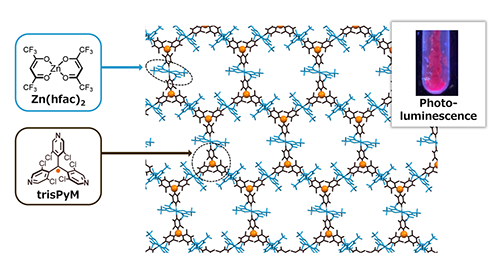In recent years, researchers have focused on a new type of coordination polymer with unpaired electrons that have extremely useful attributes for the next generation of electronic devices, including in the use of 'spintronics', but which are notoriously unstable or poor-crystalline. Here, a group of scientists from Japan has managed to wrangle them and make them air-stable and highly-crystalline via a novel molecular recipe.
-------------------------------------------------------------------------------
Coordination polymers (CPs) composed of organic radicals have been the focus of much research attention in recent years due to their potential application to a wide variety of next-generation electronics, from more flexible devices to 'spintronics' storage of information. Sadly, they often suffer from their limited stability and poor crystallinity. Researchers from Japan's Institute for Molecular Science (IMS), National Institute of Natural Sciences (NINS) have developed a novel recipe that not only produces a stable material, but offers a variety of other useful attributes.
Their findings appear in the journal Journal of the American Chemical Society on March 15.
Materials with unpaired electrons on 2D honeycomb lattices have attracted much attention as potential candidates for future electronic, spintronic, and photonic device applications. An organic radical based coordination polymer (CP) is a candidate of such materials, and has a structure containing metal atoms at the center of the repeating sequence of organic radicals. Several radical-based CPs with honeycomb lattice structures have been prepared so far, in-depth investigation on their functions and materials development are often hindered due to their instability and poor-crystallinity.
Radicals are what we call an atom or molecule that has an electron in its outer shell that is unpaired. This lack of pairing with another electron makes it extremely reactive with other substances, and so radicals tend to be very short-lived. There are, however, some radicals that are long-lived even in everyday temperature and pressure conditions. These stable radicals demonstrate electrical, magnetic, and photoemission properties, as inorganic materials such as metals, oxides, and chalcogenides exhibit.
"Stable, highly-crystalline radical-based CPs with honeycomb lattice structures have a great potential to expand the utility of this class of materials in future application. But even though such materials are in principle possible, the design and synthesis have been pretty elusive," said Tetsuro Kusamoto of IMS at NINS.
The IMS team has produced a 'recipe' for such CPs that manages to be long-lived under ambient conditions. It uses an entirely new, triangular-shaped organic radical, tris(3,5-dichloro-4-pyridyl)methyl radical, or trisPyM. This radical is not just stable but also exhibits photoluminescence in solution and solid states. In addition, by combining trisPyM with a zinc-containing molecule, ZnII(hexafluoroacetylacetonato)2,--into what they call trisZn, the researchers produced a stable, crystalline, and photoluminescent radical-based CP with a 2D honeycomb lattice structure.
"trisZn is just a proof of concept of our recipe, and a plenty of radical-based CPs can in principle be produced by simply employing different metal ions or metal complex units. I hope some of these materials find real-world applications or exhibit unprecedented phenomena that advance materials science." Tetsuro said.

Fig. 1. A 2D honeycomb lattice structure of a radical-based coordination polymer, trisZn, constructed from trisPyM and Zn(hfac)2. Photoluminescence from trisZn is shown.
Information of the paper
Authors: Shun Kimura, Motoyuki Uejima, Wataru Ota, Tohru Sato, Shinpei Kusaka, Ryotaro Matsuda, Hiroshi Nishihara, and Tetsuro Kusamoto
Journal Name: Journal of the American Chemical Society
Journal Title: "An Open-shell, Luminescent, Two-Dimensional Coordination Polymer with a Honeycomb Lattice and Triangular Organic Radical"
DOI: 10.1021/jacs.0c13310
Financial Supports
Grant-in-Aid for Scientific Research
(26220801, 20H02759, 18K05261, 19H05460, 18J21163)
Japan Science and Technology Agency
(JPMJPR20L4, JPMJCR15F2)
Contact Person
Tetsuro Kusamoto
TEL/FAX: +81-564-59-5520 / +81-564-59-5585
E-mail:kusamoto_at_ims.ac.jp
(Please replace the "_at_" with @)
4214

